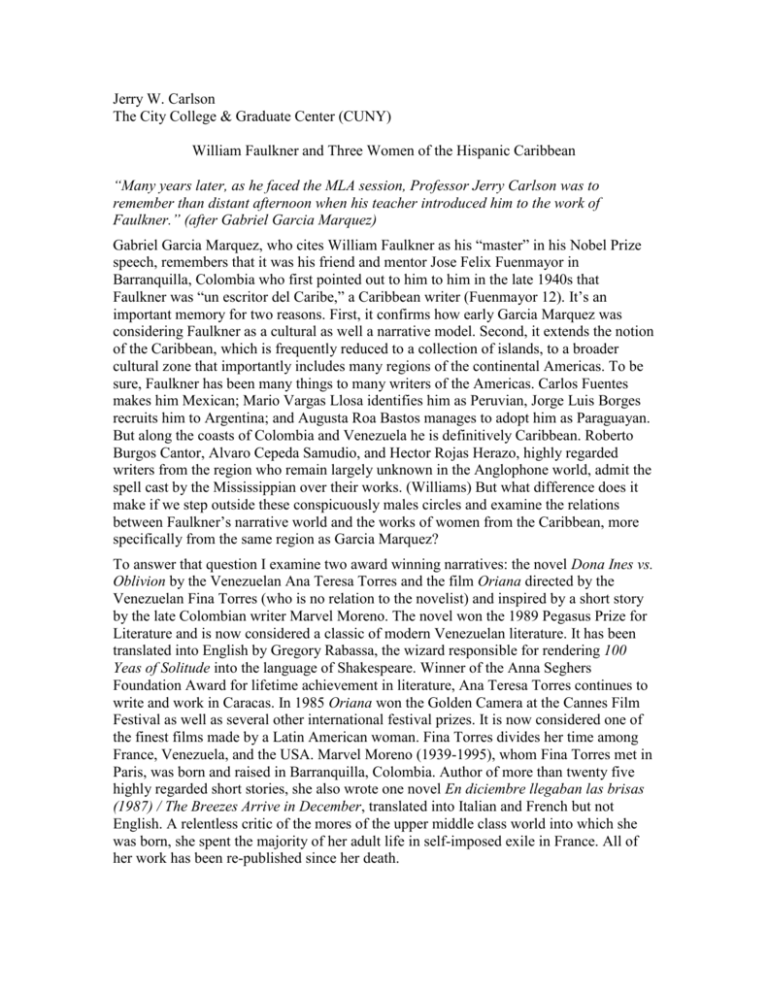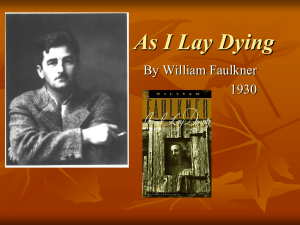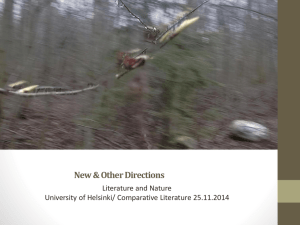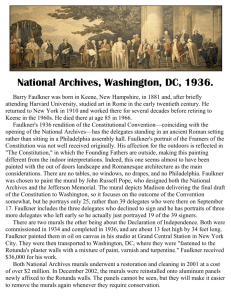Faulkner and Three Women of the Hispanic Caribbean
advertisement

Jerry W. Carlson The City College & Graduate Center (CUNY) William Faulkner and Three Women of the Hispanic Caribbean “Many years later, as he faced the MLA session, Professor Jerry Carlson was to remember than distant afternoon when his teacher introduced him to the work of Faulkner.” (after Gabriel Garcia Marquez) Gabriel Garcia Marquez, who cites William Faulkner as his “master” in his Nobel Prize speech, remembers that it was his friend and mentor Jose Felix Fuenmayor in Barranquilla, Colombia who first pointed out to him to him in the late 1940s that Faulkner was “un escritor del Caribe,” a Caribbean writer (Fuenmayor 12). It’s an important memory for two reasons. First, it confirms how early Garcia Marquez was considering Faulkner as a cultural as well a narrative model. Second, it extends the notion of the Caribbean, which is frequently reduced to a collection of islands, to a broader cultural zone that importantly includes many regions of the continental Americas. To be sure, Faulkner has been many things to many writers of the Americas. Carlos Fuentes makes him Mexican; Mario Vargas Llosa identifies him as Peruvian, Jorge Luis Borges recruits him to Argentina; and Augusta Roa Bastos manages to adopt him as Paraguayan. But along the coasts of Colombia and Venezuela he is definitively Caribbean. Roberto Burgos Cantor, Alvaro Cepeda Samudio, and Hector Rojas Herazo, highly regarded writers from the region who remain largely unknown in the Anglophone world, admit the spell cast by the Mississippian over their works. (Williams) But what difference does it make if we step outside these conspicuously males circles and examine the relations between Faulkner’s narrative world and the works of women from the Caribbean, more specifically from the same region as Garcia Marquez? To answer that question I examine two award winning narratives: the novel Dona Ines vs. Oblivion by the Venezuelan Ana Teresa Torres and the film Oriana directed by the Venezuelan Fina Torres (who is no relation to the novelist) and inspired by a short story by the late Colombian writer Marvel Moreno. The novel won the 1989 Pegasus Prize for Literature and is now considered a classic of modern Venezuelan literature. It has been translated into English by Gregory Rabassa, the wizard responsible for rendering 100 Yeas of Solitude into the language of Shakespeare. Winner of the Anna Seghers Foundation Award for lifetime achievement in literature, Ana Teresa Torres continues to write and work in Caracas. In 1985 Oriana won the Golden Camera at the Cannes Film Festival as well as several other international festival prizes. It is now considered one of the finest films made by a Latin American woman. Fina Torres divides her time among France, Venezuela, and the USA. Marvel Moreno (1939-1995), whom Fina Torres met in Paris, was born and raised in Barranquilla, Colombia. Author of more than twenty five highly regarded short stories, she also wrote one novel En diciembre llegaban las brisas (1987) / The Breezes Arrive in December, translated into Italian and French but not English. A relentless critic of the mores of the upper middle class world into which she was born, she spent the majority of her adult life in self-imposed exile in France. All of her work has been re-published since her death. The first thing to say about these works and their authors is that they do not cite Faulkner as a direct influence as their male counterparts do. Faulkner arrives in their world as an accepted presence, a determining influence upon the narrative worlds created by the socalled, previously mentioned masculine (in some cases, distinctly macho) Boom writers. It is hard to overestimate the shadow cast by 100 Years of Solitude over the Caribbean and Latin American literature of the past thirty five years. (This includes, by the way, recent rejection by young urban writers who say that they live in McCondo not the mythical Macondo.) As we know, shadows do more than cover. They can just as easily hide aspects of the worlds being portrayed. Here is where Ana Teresa Torres, Fina Torres, and Marvel Moreno cast their light. They address that which has been excluded or ignored in previous Faulkner influenced renderings of the histories of plantation societies of the southwest Caribbean and elsewhere. Theirs is a woman’s project but one that avoids facile oppositions of masculine and feminine. Issues of race, class, colonialism, and modernization shape gender roles in their narrative worlds in ways that defy simplification but ask for exploration. Both the novel and the film are family chronicle narratives spanning several generations. What they share with the Boom novels is a rejection of the family melodrama as an allegory of the nation. This popular tradition includes two of the most important works to promote a nostalgic image of plantation societies: The Birth of a Nation and Gone with the Wind, both faithful adaptations of equally troublesome novels of great popular success. Torres and Torres/Moreno, by contrast, offer what Ashraf Rushdy has called palimpsest narratives where “the present is always written against a background where the past is erased but still legible.” For his evidence, Rushdy cites African American novels of the 1970s in which characters “confront family secrets attesting to the ongoing effects of slavery.” (Rushdy 8) Faulkner’s entire body of work might itself be described as a master palimpsest narrative. In any case, Torres and Torres/Moreno follow the same method of excavation. They ask who owns their culture. This is both metaphorical in describing power relations among the classes and races and literal in asking who owns the property that was the plantation. Unlike melodrama where unity of family and especially its racial purity become emblems of the nation, these works seek to reveal the “other family” of the plantation and its descendant generations. In these works, as in Faulkner, denying miscegenation means denying history. Those who do, like Thomas Sutpen, are doomed to never understand the Americas in their vibrant, productive diversity. As the Martinican critic of Faulkner Edouard Glissant puts it, “the struggle against a single History for the cross-fertilization of histories means repossessing both a true sense of one’s time and identity: proposing in an unprecedented way a revaluation of power.” (Glissant 1989, 93) For these artists understanding their histories is made difficult not only by their gendered positions in the society but also by the more general condition of Caribbean modernity. It is achieved, as Glissant argues, not by continuous historical development but by “irruption.” (Glissant 1989, 146) History, in this view, is less a well shaped plot than “a polyphony of dramatic shocks.” (Glissant 1989, 106) Turning those shocks into histories, into narratives is the challenge faced by the creators, narrators, and characters of Dona Ines vs. Oblivion and Oriana. Oriana uses a traditional investigative structure to reconstruct three generations of family experience that issues from a single hacienda. Maria, a Venezuelan woman of forty who lives in France with a French husband, is summoned to coastal Venezuela to take possession of a hacienda willed to her by her aunt Oriana. As she prepares the house for sale, she revisits by flashback an earlier summer visit as a young teenager to meet her aunt for the first time. During that stay she became fascinated with her aunt’s life story, especially her decision to remain as caretaker of the hacienda as all other members of the family moved to Caracas. Eventually the project of piecing together the family history overwhelms the task of selling the house. Maria has become the ultimate Eurocentric cosmopolitan Venezuelan. Each step back into the past brings her closer to the Americas. These steps do not come easily at first. When she first gets the news of her inheritance and the need to return to Venezuela, she responds by taking a sedative. As the fragments of family history begin to cohere her modes of recovery change. She begins a reticent investigator. However, involuntary flashbacks triggered by Proustian cues take control of the process. After several revelations, she once again takes charge for herself and turns into a highly speculative investigator – a possible housemate of Quentin and Shreve in Absalom! Absalom! . She fills the narrative with probable but unverifiable incidents to make it coherent and truthful in the largest sense. What she finally understands is that she is not the rightful owner of the hacienda. It is her cousin, aunt Oriana’s child who has been unacknowledged by the family. He is more than a child born out of wedlock. He is a product of the confusion between the official family of the hacienda and the “other” families sired by Oriana’s father. He brings one of those meztizo children Sergio to the house but never acknowledges him as a son. As Oriana grows into adolescence, she falls in love with her half brother, whose identity she does not initially know. Once she finds out, it is too late. Their passion is unstoppable. Their affair eventuates in Sergio’s murder by his father, the father’s murder by the women of the house, and the birth of Oriana’s son. All of this is conveniently forgotten by the family as it assumes its role in the modernity of Caracas and as Maria shapes herself into being a European. Oriana’s plan is to preserve her own history of the family and its origins in the patriarchal order of plantation society by transmitting it to Maria. She does this first by sparking Maria’s curiosity as an adolescent and then by setting the hacienda as a trap for Maria once she returns. Seemingly unworldly and isolated, Oriana is actually a cunning trickster. In the film’s mise-en-scene the house has a privileged place as one would expect. It fulfills the essential protocols of a gothic space ripe with secrets. Equally important, it functions as what historian Pierre Nora designates as les lieux de memoire / sites of memory. These exist because real milieux de memoire / environments of memory have been destroyed by rapid historical changes, in this case Glissant’s irruption of modernity. “ If (patriarchal plantation my addition) history” as Nora puts it, “did not besiege memory, deforming and transforming, penetrating and petrifying it, there would be no lieux de memoire. Indeed, it is this very push and pull that produces lieux de memoire – moments of history torn away from the movement of history, then returned.” (Nora 284, 289) Using the house as lieux de memoire, Oriana succeeds in re-emploting family history by revealing and transmitting it to Maria. Dona Ines, the female narrator and protagonist of Dona Ines vs. Oblivion, is also attached to her house, so much so that she remains there for three hundred years to tell the history of the future of her family. She is a spectral narrator who can see all, comment upon it, but not influence its outcome. Highly opinionated, she is an unreliable ghost. Unlike Oriana who speaks for the “other” members of plantation society, Dona Ines wishes to be a censor. A proud aristocrat, she is more a proponent of the official history than her husband Alejandro. He has created a messy history by siring an “other” family. Worse yet, he encourages his mulatto son Juan to take control of certain distant coastal plantations lands. Doing so keeps him at an advantageous distance from Dona Ines but also gives him a strong sense of ownership. What follows is a dispute over the land. As Venezuela moves from colony to republic, from rural to urban, the lawsuits follow the changes in legal systems and the shapes of the two families. Dona Ines assumes that everyone will follow her interests with equal passion. Disappointment is her fate. Ranting is her response. If the narrative movement of Oriana is backwards to the discovery of the “other” families and their place in Caribbean history, Torres’ novel moves relentlessly forward to explore, much to the displeasure of Dona Ines, the consequences of racial bifurcation. The scope of the novel is from 1715 until 1985. Its three parts are divided into eighteen chapters. Dona Ines serves as the guiding narrator through the centuries. She always addresses her beloved husband Alejandro and her nemesis the mulatto son Juan, although they do not engage in dialogue with her. Dona Ines fails to control the narrative just as completely as she fails to settle the property dispute favorably. An illiterate like most women of her class in the 18th century, Dona Ines addresses an equally spectral scribe to tell her tale. She wants her word to be part of the papers that constitute the official record of the society. She wishes to be comprehensive but fails. She must rely upon other voices to tell their own stories. In Bahktinian terms, she wants to write a monologic narrative but finds that she must produce a dialogic one. In its compositional principles the novel evokes the Faulkner of Go Down Moses and Absalom! Absalom! In both Torres and Faulkner, the desire on the part of certain characters to control history by controlling the discourses that produce its archives are challenged by voices and events that are beyond containment. Torres’s contribution to a Faulknerian analysis of New World plantation societies is her portrayal of the complicity and passion of some women in creating and maintaining a society based upon strictly held hierarchies of gender, race, and class. Torres traces the legacy from its origins in southern Spain to its consequences amid the skyscrapers of oil wealthy Caracas with its rings of hillside shanties. In doing so, Torres asserts her own authority as a writer, the source for the many styles and discourses that tell Dona Ines’ story even as she would not want it told. Torres’ exercise of language in Spanish or in Gregory Rabassa’s elegant translation is Faulknernian in its scope, rhythm, and baroque density. This stylistic affinity may be as close to direct influence as we find. Let us close by reading Torres and listening to Dona Ines. My life has been a passage through slow mornings, long days that time ran through sluggishly as I supervised the work of the slave women, watching them sweep the flagstones in the courtyard, polish the floor tiles and the glaze wall mosaics I’d had brought from Andalucia, gather the fallen leaves from the lemon tree, and water the guava tree in the yard; embroidering a point or two on a mantle or taking a turn through the kitchen to taste the soup and see that everything was as it should be before Alejandro’s arrival and asking him during lunch what has been discussed at the council, what the price for cacoa was and whether the ship carrying it has sunk. Sleeping an unhurried siesta later when the heat grew stronger and preparing myself for the gracious reception of visitors, giving orders and overseeing the preparation of sweetmeats and teas served on the porcelain plates and gilded glasses that I had had imported from France, waiting for the ladies to arrive and then for the slave girls to take their cloaks in the entranceway, suiting in the parlor with my daughters, conversing, inquiring about the health of our people, commenting on how heavy the winter rains had been, speaking of husbands off on their plantations, or processions, or of the party the governor was giving to ingratiate himself with us; and at the appointed hour the slave girls returned with the cloaks in a basket, and we said good-bye until soon again or until Sunday in the cathedral, where we aristocrats would be together, dressed in black and covered with capes as a sign of our privilege, escorted by two slave girls, one to chase away beggars and the other to spread a small rug over the dry brick floor of the church. At dusk all assembling, children and slaves, to recite the holy rosary in the chapel, dining in silence, and while Alejandro went over the accounts that the plantation administrator showed him, and I was playing solitaire, the children were already asleep and the crickets could be heard in the courtyard. (Torres 3-4)






